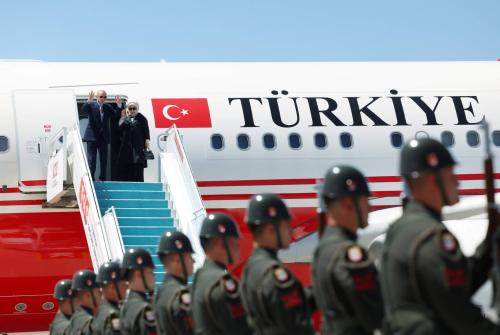The United States and Russia are implementing the New START Treaty, which requires that each side reduce to no more than 1550 deployed strategic warheads on no more than 700 deployed strategic missiles and bombers by 2018. The Obama administration would like to go further. Doing so, however, will require that Washington address several related issues, first and foremost missile defense. Solutions on these issues are possible, if both Washington and Moscow are prepared to engage seriously.
In June 2013 in Berlin, President Obama proposed to reduce New START’s limit of 1550 deployed strategic warheads by one-third and called for “bold” though unspecified reductions in non-strategic nuclear weapons (NSNW, also referred to as tactical nuclear weapons). Administration officials have said privately that Washington also is prepared to make corresponding reductions in deployed strategic missiles and bombers, as well as in New START’s limit on deployed and non-deployed missile launchers and bombers.
Following New START’s entry into force in 2011, U.S. officials expressed interest in negotiating an agreement that would constrain all U.S. and Russian nuclear weapons – strategic and non-strategic, deployed and non-deployed – under a single aggregate limit, perhaps with a sublimit on deployed strategic warheads. That would mean that, for the first time, all U.S. and Russian nuclear weapons would be on the negotiating table.
U.S. officials have shown less interest in such an approach recently, believing that such a “big” treaty would require considerable time to negotiate and likely would not be finished during the remainder of President Obama’s time in office. (It would be best to submit a treaty to the Senate for consideration before 2016, a presidential election year, so such a treaty would need to be finished in 2015.) U.S. officials now talk of taking different approaches to limits on different classes of nuclear arms. While the U.S. government seeks to reduce the numerical limits in New START, it is consulting with NATO on transparency and confidence-building measures regarding non-strategic nuclear weapons, which may be necessary first steps for engaging Russia on reducing such weapons.
For its part, Moscow has shown little enthusiasm for nuclear reductions beyond those required by New START and has said that other questions must be addressed in conjunction with a discussion of further reductions. These include: differences over missile defense, treatment of conventional prompt global strike systems, multilateralization of the nuclear arms reduction process, limitations on conventional forces in Europe and outer space. With regard to NSNW, Russian officials have said that all such weapons should be withdrawn to national territory – which would require the removal of some 200 U.S. nuclear bombs from Europe – as a precondition for any negotiation. U.S. officials reject the precondition but allow the possibility that this could be the outcome of a negotiated agreement.
The manner in which Moscow has drawn these linkages reflects Russian concerns about U.S. advantages in these areas, which the Russians say could undercut the balance in strategic nuclear forces established by New START. Some question Russia’s general readiness for further reductions and believe that the purpose of the linkages may be to give Moscow a pretext not to reduce beyond New START, at least for the present.
While U.S. military forces have developed certain leads in missile defense and high-tech conventional weapons, it is important not to overstate U.S. military superiority or advantages. The American military has just disengaged from a long effort in Iraq, is drawing down from an even lengthier campaign in Afghanistan, faces significant budget cuts, and must recapitalize its military equipment holdings. Most U.S. allies in Europe likewise face significant budget reductions, while the Russian military has embarked on a major modernization program.
That said, Washington appears to understand that, if it wishes to make progress on further nuclear arms reductions, it must address at least some of the linked questions posed by Moscow. It should be possible to do so. The rest of this paper will explore how.
The Heinrich Böll Foundation in Berlin, in conjunction with the German Institute for International and Security Affairs and the Institute for Peace Research and Security Studies (IFSH) at the University of Hamburg, held an experts’ workshop on the “Future of Arms Control” in September. Brookings Senior Fellow Steven Pifer prepared a proceedings paper, “U.S. Military Advantages and the Future of Nuclear Arms Control,” which appears below.
Read the full proceedings of the conference »
The Brookings Institution is committed to quality, independence, and impact.
We are supported by a diverse array of funders. In line with our values and policies, each Brookings publication represents the sole views of its author(s).



Commentary
Op-edU.S. Military Advantages and the Future of Nuclear Arms Control
December 20, 2013